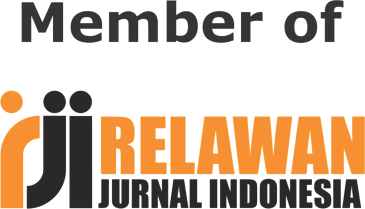Digital Piracy: Factors on Using Software Piracy in Islamic Higher Education
Abstract
This research was conducted to identify and analyze the factors that lead to the use of pirated software among lecturers at UIN Ar-Raniry Banda Aceh and to determine the impact of using pirated software. The research method used is of quantitative type with factor analysis techniques. The study sample was 114 people. The sampling technique used is convenience sampling. The data was obtained through the distribution of questionnaires to respondents, which were further analyzed using the factor analysis method. The Kaiser Meyer Olkin Measure of Sampling test results were 0.801, and the Bartlett test was equal to 153. The next stage applies the principal component analysis method to obtain four new formation factors. They are named the motivation factor consisting of 9 variables; the attitude factor consisting of 4 variables; the legal factor consisting of 2 variables; and the quality & price factor consisting of 3 variables. The results achieved can be a reference and consideration for the campus in digital transformation using original software. The research implications contribute to a paradigm shift for lecturers to use licensed software. Socially, compliance with the regulation of the use of licensed software creates a favorable academic environment and has an impact on increasing lecturer productivity.
Downloads
References
M. Astuti, Z. Arifin, F. Mutohhari, and M. Nurtanto, “Competency of Digital Technology: The Maturity Levels of Teachers and Students in Vocational Education in Indonesia,” J. Educ. Technol., vol. 5, no. 2, Jun. 2021, doi: 10.23887/jet.v5i3.35108.
H. Wulandari, “Economy and technology as influential factors for digital piracy sustainability: An Indonesian case,” Procedia - Soc. Behav. Sci., vol. 164, pp. 114–117, 2014.
M. N. O. Sadiku, M. Tembely, and S. M. Musa, “Software Piracy: A Primer,” Int. J. Adv. Res. Comput. Sci. Softw. Eng., vol. 8, no. 5, p. 97, Jun. 2018, doi: 10.23956/ijarcsse.v8i5.680.
J. A. Chavarria, F. K. Andoh-Baidoo, V. Midha, and J. Hughes, “Software Piracy Research: A Cross Disciplinary Longitudinal Literature Survey,” Commun. Assoc. Inf. Syst., vol. 38, pp. 624–669, 2016, doi: 10.17705/1CAIS.03831.
M. Gergely and V. S. Rao, “A Cross-National Experimental Examination of Software Piracy Behavior,” in Twenty-third Americas Conference on Information Systems, 2017, pp. 1–5. [Online]. Available: https://core.ac.uk/download/pdf/301371795.pdf
N. K. Sari, “Penegakan Hukum Terhadap Pelanggaran Hak Cipta Pembajakan Software di Indonesia,” QISTIE, vol. 6, no. 1, pp. 14–24, Jan. 2012, doi: 10.31942/jqi.v6i1.551.
J. Nie, L. Zhong, G. Li, and K. Cao, “Piracy as an entry deterrence strategy in software market,” Eur. J. Oper. Res., vol. 298, no. 2, pp. 560–572, Apr. 2022, doi: 10.1016/j.ejor.2021.06.006.
A. Mardalis and P. S. Dharma, “Faktor-Faktor Yang Mempengaruhi Penggunaan Software Bajakan Di Kalangan Mahasiswa,” BENEFIT J. Manaj. dan Bisnis, vol. 16, no. 2, pp. 99–105, 2012, [Online]. Available: https://journals.ums.ac.id/index.php/benefit/article/view/1361/917
P. Alleyne, S. Soleyn, and T. Harris, “Predicting Accounting Students’ Intentions to Engage in Software and Music Piracy,” J. Acad. Ethics, vol. 13, no. 4, pp. 291–309, Dec. 2015, doi: 10.1007/s10805-015-9241-7.
F. Rahman and P. Pandey, “Online Software Piracy and Its Related Laws,” SSRN Electron. J., 2020, doi: 10.2139/ssrn.3648512.
N. A. Omar, Z. Z. Mohd Zakuan, and R. Saian, “Software Piracy Detection Model Using Ant Colony Optimization Algorithm,” J. Phys. Conf. Ser., vol. 855, p. 012031, Jun. 2017, doi: 10.1088/1742-6596/855/1/012031.
R. Meireles and P. Campos, “Digital Piracy: Factors that Influence the Intention to Pirate – A Structural Equation Model Approach,” Int. J. Human–Computer Interact., vol. 35, no. 12, pp. 1046–1060, Jul. 2019, doi: 10.1080/10447318.2018.1507783.
D. Arli, F. Tjiptono, R. Casidy, and I. Phau, “Investigating the impact of young consumers’ religiosity on digital piracy,” Int. J. Consum. Stud., vol. 42, no. 6, pp. 792–803, Nov. 2018, doi: 10.1111/ijcs.12443.
D. Arli and F. Tjiptono, “The End of Religion? Examining the Role of Religiousness, Materialism, and Long-Term Orientation on Consumer Ethics in Indonesia,” J. Bus. Ethics, vol. 123, no. 3, pp. 385–400, Sep. 2014, doi: 10.1007/s10551-013-1846-4.
S. S. Jamwal and N. Gupta, “Demographic Factors of Software Piracy,” IJCSC, vol. 6, no. 1, pp. 129–139, 2015.
Himawan, P. Irfansyah, F. Ismawan, I. Mutia, and T. W. Harjanti, “Research Ethics in Computer Science Publications: Critical Studies,” in Proceedings of the 1st International Conference on Folklore, Language, Education and Exhibition (ICOFLEX 2019), 2020, pp. 318–324. doi: 10.2991/assehr.k.201230.060.
A. P. Wicaksono and D. Urumsah, “Perilaku Pembajakan Produk Digital: Cerita Dari Mahasiswa di Yogyakarta,” J. Apl. BISNIS, vol. 17, no. 1, pp. 22–42, 2017, [Online]. Available: https://journal.uii.ac.id/JABIS/article/view/8249/7086
Q. T. Pham, N. M. Dang, and D. T. Nguyen, “Factors Affecting on the Digital Piracy Behavior: An Empirical Study in Vietnam,” J. Theor. Appl. Electron. Commer. Res., vol. 15, no. 2, pp. 122–135, 2020, [Online]. Available: http://dx.doi.org/10.4067/S0718-18762020000200108
A.-M. Suduc, M. Bizoi, and F. G. Filip, “Ethical Aspects on Software Piracy and Information and Communication Technologies Misuse,” IFAC Proc. Vol., vol. 42, no. 25, pp. 30–35, Jan. 2009, doi: 10.3182/20091028-3-RO-4007.00008.
Ł. Tomczyk, “Evaluation of Digital Piracy by Youths,” Futur. Internet, vol. 13, no. 1, p. 11, Jan. 2021, doi: 10.3390/fi13010011.
A. Muqorobin, “Penggunaan Software Bajakan Di Lembaga Keuangan Syariah Dalam Perspektif Kepemilikan Islam (Studi Kasus Bmt Surya Mandiri, Ponorogo Tahun 2018),” in Manajemen, Akuntansi dan Perbankkan 2018, 2018, pp. 1003–1016. [Online]. Available: http://conferences.uin-malang.ac.id/index.php/semnasfe/article/view/828
S. Goode and S. Cruise, “What Motivates Software Crackers?,” J. Bus. Ethics, vol. 65, no. 2, pp. 173–201, May 2006, doi: 10.1007/s10551-005-4709-9.
S. A. Asongu, “Global Software Piracy, Technology and Property Rights Institutions,” J. Knowl. Econ., vol. 12, no. 3, pp. 1036–1063, Sep. 2021, doi: 10.1007/s13132-020-00653-1.
S. Okide, D. Neboh, C. N. Asogwa, and C. H. Ugwuishiwu, “The Role of Information Technology on Software Piracy, Its Consequences and the Way Forward,” Int. J. Innov. Res. Sci. Eng. Technol., vol. 6, no. 6, pp. 10159–10169, 2017, doi: 10.15680/IJIRSET.2017.0606006.
M. A. Novalito, “Pencegahan Pembajakan Software di Kota Medan,” Universitas Muhammadiyah Sumatera Utara Medan, 2018. [Online]. Available: http://repository.umsu.ac.id/handle/123456789/10119
F. Ullah et al., “Cyber Security Threats Detection in Internet of Things Using Deep Learning Approach,” IEEE Access, vol. 7, pp. 124379–124389, 2019, doi: 10.1109/ACCESS.2019.2937347.
B. Lee, R. Fenoff, and S. Y. Paek, “Correlates of participation in e-book piracy on campus,” J. Acad. Librariansh., vol. 45, no. 3, pp. 299–304, May 2019, doi: 10.1016/j.acalib.2019.04.002.
S. Asongu and C. Meniago, “Technology and persistence in global software piracy,” NETNOMICS Econ. Res. Electron. Netw., vol. 19, no. 1–2, pp. 43–63, Oct. 2018, doi: 10.1007/s11066-018-9126-1.
M. Sari, R. S. Sadjad, and M. Nadjib, “Tinjauan Hukum Media Massa Terhadap Penggunaan Software Bajakan Dikalangan Mahasiswa Di Kota Makassar,” J. Komun. KAREBA, vol. 1, no. 4, pp. 399–410, 2011, doi: https://doi.org/10.31947/kjik.v1i4.320.
M. S. Sohail, “Consumer influences on pirated software purchases: perspectives from an emerging Gulf nation,” Int. J. Glob. Mark., vol. 5, no. 1, pp. 43–56, 2012, [Online]. Available: https://papers.ssrn.com/sol3/papers.cfm?abstract_id=2653658
S. Alhawari and A. N. Talet, “Ethical Decision Making with Information Systems Students,” Int. J. Cyber Ethics Educ., vol. 1, no. 2, pp. 41–53, Apr. 2011, doi: 10.4018/ijcee.2011040104.
C. W. Yoo, M. Kim, Y. C. Choe, and V. Q. Tuan, “Factor motivating software piracy in Vietnam,” 2008. [Online]. Available: https://aisel.aisnet.org/amcis2008/264
M. C. Utami, “Analisis Faktor-Faktor Yang Mempengaruhi Dosen Dalam Melanjutkan S3 Dengan Metode Principal Component Analysis (Studi Kasus: Program Studi Si/Ti Fst Uin),” J. Sist. Inf., vol. 6, no. 1, pp. 1–7, 2013, [Online]. Available: http://journal.uinjkt.ac.id/index.php/sisteminformasi/article/view/313
Basrul and H. Ahmadian, “Overview Of Pirated Software On Campus: Educators’ Perspective,” Cybersp. J. Pendidik. Teknol. Inf., vol. 4, no. 2, pp. 118–128, 2020.
A. Mardalis and P. S. Dharma, “Faktor-Faktor Yang Mempengaruhi Penggunaan Software Bajakan Di Kalangan Mahasiswa,” BENEFIT J. Manaj. dan Bisnis, vol. 16, no. 2, pp. 99–105, 2012, doi: 10.23917/benefit.v16i2.1361.
A. T. Pradana, “Pengaruh Attitude Toward Pirated Software, Subjective Norms, Perceived Behavioural Control, Past Piracy Behaviour, Dan Moral Obligation Pada Use Intention of Pirated Software,” Universitas Sebelas Maret, 2012.
A. Hossain, A. K. Das, N. Tasnim Mim, J. Hoque, and R. A. Tuhin, “Software Piracy: Factors and Profiling,” in 2019 2nd International Conference on Applied Information Technology and Innovation (ICAITI), Sep. 2019, pp. 213–219. doi: 10.1109/ICAITI48442.2019.8982130.
Q. T. Pham, N. M. Dang, and D. T. Nguyen, “Factors Affecting on the Digital Piracy Behavior: An Empirical Study in Vietnam,” J. Theor. Appl. Electron. Commer. Res., vol. 15, no. 2, pp. 0–0, 2020, doi: 10.4067/S0718-18762020000200108.
X. Liu, Zhiyuan; Yu, Yuexiang; Lv, Jikun; and Zhang, “An economic analysis of software piracy in a competitive cloud computing market: A product bundling perspective,” 2022. [Online]. Available: https://aisel.aisnet.org/iceb2022/5
B. K. Jeong, T. Yoon, and S. S. Khan, “Improving the Effectiveness of Anti-Piracy Educational Deterrence Efforts: The Role of Message Frame, Issue Involvement, Risk Perception, and Message Evidence on Perceived Message Effectiveness,” J. Theor. Appl. Electron. Commer. Res., vol. 16, no. 3, pp. 298–319, Nov. 2020, doi: 10.3390/jtaer16030021.
FITRIASIH, S. R. Hijrah HATI, and A. ACHYAR, “Book Piracy Behavior among College Students in Indonesia,” J. e-Learning High. Educ., pp. 1–11, Sep. 2019, doi: 10.5171/2019.253359.
D. Arli, K. Kubacki, F. Tjiptono, and S. Morenodiez, “Religiousness and digital piracy among young consumers in an emerging market,” Young Consum., vol. 18, no. 1, pp. 40–53, Apr. 2017, doi: 10.1108/YC-08-2016-00627.
Copyright (c) 2023 Digital Zone: Jurnal Teknologi Informasi dan Komunikasi

This work is licensed under a Creative Commons Attribution-ShareAlike 4.0 International License.











